Small overlap front: driver-side
Rating applies to 2012-19 models built after July 2011
Tested vehicle: 2013 Fiat 500 Pop 2-door
The Fiat 500 was introduced in the 2012 model year. Fiat Chrysler modified the seat structure to improve occupant protection in frontal crashes beginning with 2012 models manufactured after July 2011. (Information about when a specific vehicle was manufactured is on the certification label typically affixed to the car on the driver door or adjacent B-pillar.)
| Evaluation criteria | Rating |
|---|---|
| Structure and safety cage | |
| Driver injury measures | |
| Head/neck | |
| Chest | |
| Hip/thigh | |
| Lower leg/foot | |
| Driver restraints and dummy kinematics The driver door hinges were torn apart and the door opened at the front, which shouldn't happen because the driver could be partly or completely ejected from the vehicle. The dummy’s head barely contacted the frontal airbag before sliding off the left side as the steering column moved 11 cm to the right, leaving the head vulnerable to contact with forward side structure. The side curtain airbag deployed but does not have sufficient forward coverage to protect the head from contact with forward side structure and outside objects. The side torso airbag deployed. | |

Action shot taken during the small overlap frontal crash test.
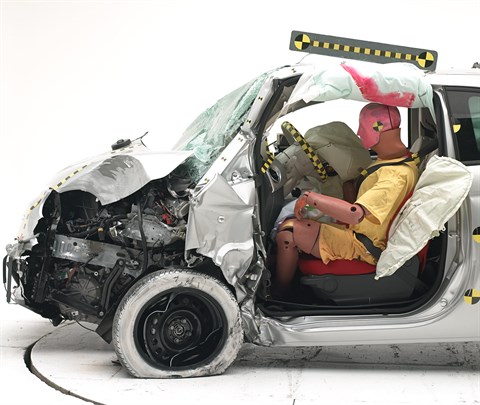
The dummy's position in relation to the door frame, steering wheel, and instrument panel after the crash test indicates that the driver's survival space was not maintained well.
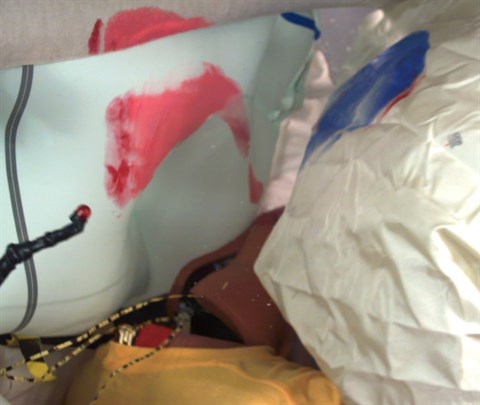
During the crash, the dummy's head and torso barely contacted the airbag before sliding off to the left as the steering column moved to the right. The inflated part of the side curtain airbag did not extend far enough forward toward the A-pillar.
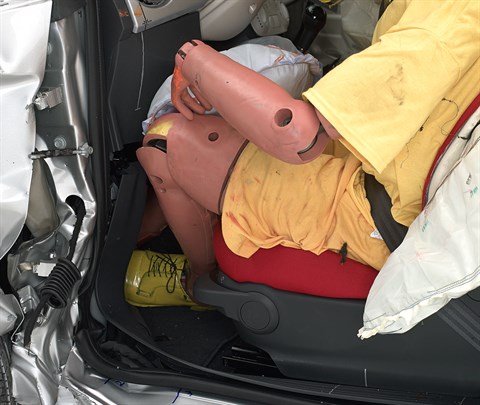
Instrument panel and door hinge pillar intrusion was extensive and contributed to a high risk of injury to the left lower leg, a significant risk to the left thigh, and a possible risk of injury to the right lower leg.
Moderate overlap front: original test
Rating applies to 2012-19 models built after July 2011
Tested vehicle: 2012 Fiat 500 Sport 2-door
The Fiat 500 was introduced in the 2012 model year. Two tests of a 2012 Fiat 500 were conducted. In the first test, forces recorded on the dummy's head were high when it hit the steering wheel through the airbag, indicating that head injuries would be possible. Postcrash investigation revealed that a steel cross tube in the seat structure was pulled out at one end and contributed to the seat pitching forward during the crash and the dummy's head moving too far forward into the airbag. In response, Fiat Chrysler modified the seat structure to improve occupant protection in frontal crashes beginning with cars manufactured after July 2011. (Information about when a specific vehicle was manufactured is on the certification label typically affixed to the car on the driver door or adjacent B-pillar.)
In the second test of a car built after the seat modifications were in place, forces on the dummy's head were reduced, but the driver door unlatched. Because the front end structure of the car was not affected by the seat modifications or the door opening, structure ratings are based on both tests.
Postcrash investigation indicates that the door opening occurred because the dummy's arm broke the interior door handle, and the access hole for a bolt at the dummy's elbow engaged and activated the door latch. The door opening in the second test is an artifact of the dummy arm construction. Therefore, it is unlikely that in an actual crash the door latch would be activated.
| Evaluation criteria | Rating |
|---|---|
| Overall evaluation | |
| Structure and safety cage | |
| Driver injury measures | |
| Head/neck | |
| Chest | |
| Leg/foot, left | |
| Leg/foot, right | |
| Driver restraints and dummy kinematics | |

Action shot taken during the second of two frontal offset crash tests.

In both tests, the dummy's position in relation to the steering wheel and instrument panel after the crash test indicates that the driver's survival space was maintained very well (second test shown).
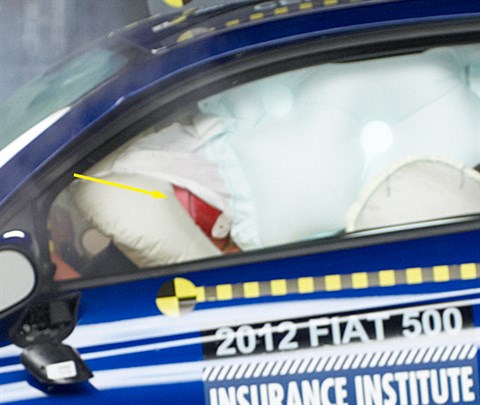
In both tests, forces recorded on the dummy's head were high when it hit the steering wheel through the airbag. In the second test (shown), forces on the head were reduced somewhat.
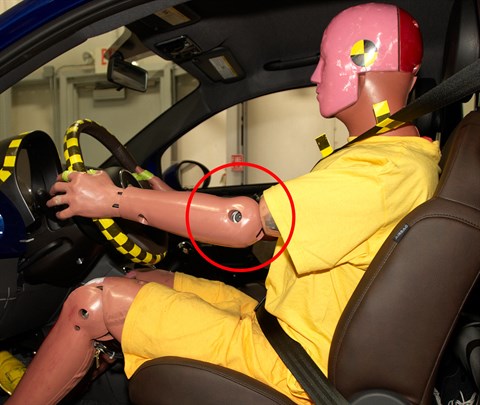
The dummy's arm broke the interior door handle, and an access hole for a bolt at the elbow (circled) engaged and activated the door latch.
Rating applies to 2012 models built before August 2011
Tested vehicle: 2012 Fiat 500 Sport 2-door
The Fiat 500 was introduced in the 2012 model year. Two tests of a 2012 Fiat 500 were conducted. In the first test as detailed here, forces recorded on the dummy's head were high when it hit the steering wheel through the airbag, indicating that head injuries would be possible. Postcrash investigation revealed that a steel cross tube in the seat structure was pulled out at one end and contributed to the seat pitching forward during the crash and the dummy's head moving too far forward into the airbag. In response, Chrysler/Fiat modified the seat structure to improve occupant protection in frontal crashes beginning with cars manufactured after July 2011. (Information about when a specific vehicle was manufactured is on the certification label typically affixed to the car on the driver door or adjacent B-pillar.)
In the second test of a car built after the seat modifications were in place, the head/neck rating improved to Acceptable, but the driver door unlatched, likely due to an artifact of the dummy's arm construction. Because the front end structure of the car was not affected by the seat modifications or the door opening, structure ratings are based on both tests.
| Evaluation criteria | Rating |
|---|---|
| Overall evaluation | |
| Structure and safety cage | |
| Driver injury measures | |
| Head/neck | |
| Chest | |
| Leg/foot, left | |
| Leg/foot, right | |
| Driver restraints and dummy kinematics | |
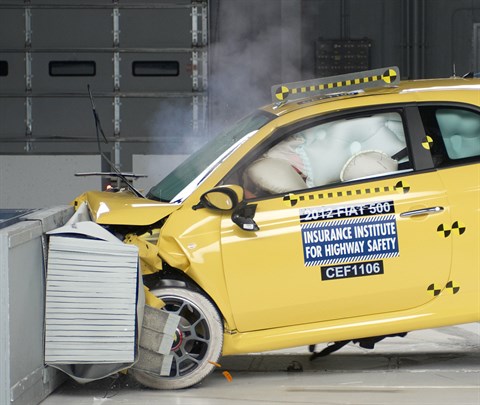
Action shot taken during the first of two frontal offset crash tests.
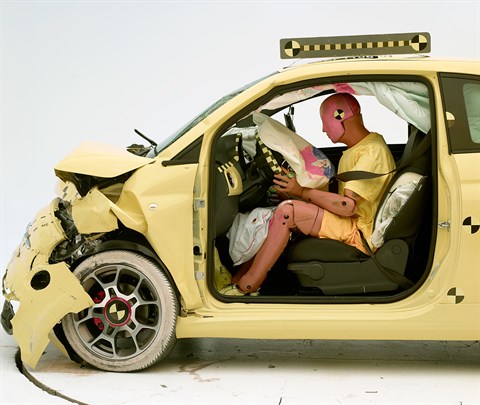
The dummy's position in relation to the steering wheel and instrument panel after the crash test indicates that the driver's survival space was maintained very well (first test shown).
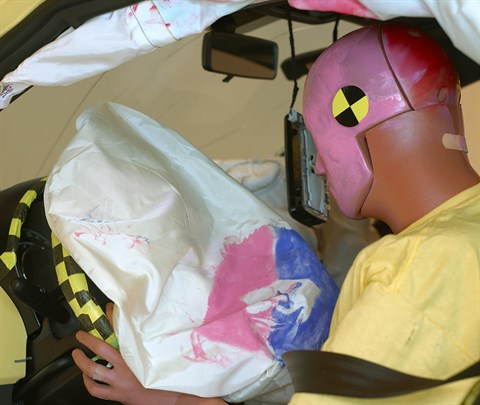
In the first test, forces recorded on the dummy's head were high when it hit the steering wheel through the airbag.

In the first test, intrusion into the driver's space was minimal, and all leg and foot injury measures were low. The dummy's knees and shins contacted the knee airbag.
Side: original test
Rating applies to 2012-19 models
Tested vehicle: 2012 Fiat 500 Sport 2-door with standard front and rear head curtain airbags and standard front seat-mounted torso airbags
The Fiat 500 was introduced in the 2012 model year.
| Evaluation criteria | Rating |
|---|---|
| Overall evaluation | |
| Structure and safety cage | |
| Driver injury measures | |
| Head/neck | |
| Torso | |
| Pelvis/leg | |
| Driver head protection | |
| Rear passenger injury measures | |
| Head/neck | |
| Torso | |
| Pelvis/leg | |
| Rear passenger head protection | |
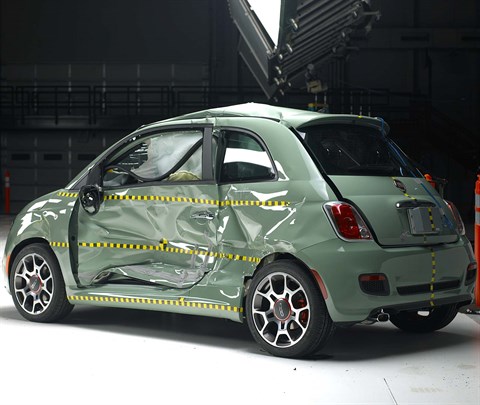
View of the vehicle just after the crash test.
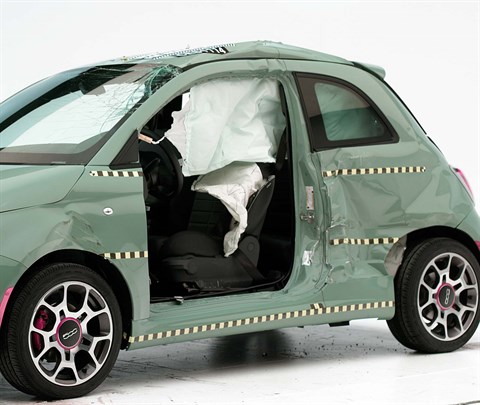
View of the vehicle after the crash with door removed, showing the side airbags and damage to the occupant compartment.

Smeared greasepaint shows where the driver dummy's head was protected from being hit by hard structures by the side curtain airbag.

Smeared greasepaint shows where the rear passenger dummy's head was protected by the side airbag.
Roof strength
Rating applies to 2012-19 models
Tested vehicle: 2012 Fiat 500 Sport 2-door
| Overall evaluation | |
|---|---|
| Curb weight | 2,469 lbs |
| Peak force | 15,221 lbs |
| Strength-to-weight ratio | 6.16 |
Head restraints & seats
Seat type: Manual leatherette seat (AHR) built after July 2011
| Overall evaluation | |
|---|---|
| Dynamic rating | |
| Seat/head restraint geometry |
Seat type: Manual leatherette seat (AHR) built before Aug 2011
| Overall evaluation | |
|---|---|
| Dynamic rating | |
| Seat/head restraint geometry |
About the head restraint & seat test
Currently, IIHS tests apply only to front seats.
